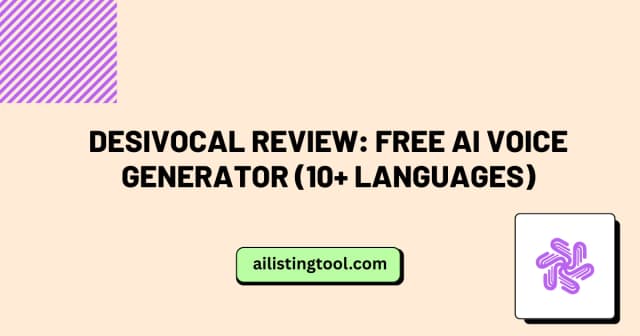How to Write SEO-Friendly AI Tool Reviews That Rank in 2025

Writing AI tool reviews isn’t just about listing features anymore. Google’s 2024-2025 algorithm updates have fundamentally changed what ranks—and generic, AI-generated reviews without real testing are getting buried in search results.
I’ve spent the past year analyzing what makes AI tool reviews actually rank and convert. The difference between reviews that get traffic and those that don’t comes down to one thing: demonstrating real experience with the tools you’re reviewing.
Let me show you exactly how to write reviews that satisfy both Google’s quality guidelines and your readers’ needs.
Why Most AI Tool Reviews Fail to Rank
Before we dive into the how-to, understand why your competitors’ reviews might be struggling:
Generic comparisons without testing. Many reviewers compile information from product pages without actually using the tools. Google’s September 2024 core update specifically targets this type of content.
Missing the “Experience” in E-E-A-T. The updated Search Quality Rater Guidelines emphasize first-hand experience. Reviews that read like product descriptions get demoted. If you’re building authority in the AI space, understanding how to build AI topical authority with an E-E-A-T strategy is essential.
Ignoring user intent. Someone searching “ChatGPT vs Claude review” wants different information than someone searching “best AI writing tool for beginners.” Most reviews treat all searchers the same.
Thin content that doesn’t satisfy needs. A 500-word review skimming features doesn’t meet Google’s “Needs Met” criteria when users expect in-depth analysis, real examples, and honest limitations.
The Framework: Writing Reviews That Actually Rank
Here’s the structure I use for every AI tool review that performs well in search:
1. Lead With Your Real Experience
Start by establishing credibility immediately. Don’t begin with generic introductions about “the rise of AI tools.”
Instead of: “Artificial intelligence is transforming how we work…”
Write: “I tested Jasper AI for three months writing 50+ blog posts for clients. Here’s what actually happened—including the $400 mistake I made in month two.”
This approach instantly signals to both readers and Google that you have genuine experience. Include specific timeframes, project types, and real outcomes from your testing.
2. Structure Around Search Intent
Different keywords signal different needs:
“[Tool name] review” → Wants comprehensive analysis, pricing, pros/cons, alternatives
“[Tool A] vs [Tool B]” → Wants direct feature comparison, use case recommendations
“best AI tool for [task]” → Wants curated list with clear winners for specific scenarios
Match your review structure to the intent. Don’t force every review into the same template. For example, our ChatGPT vs Jasper AI writing tool comparison demonstrates how to structure head-to-head reviews differently than standalone tool guides.
3. Document Your Testing Process
This is where most reviews fail. Describe exactly how you tested:
“I ran identical prompts through ChatGPT-4, Claude Sonnet, and Gemini Advanced. Each tool received the same 15 writing tasks spanning blog intros, email copy, and technical documentation. I tracked accuracy, tone consistency, and revision needs.”
Include screenshots showing:
- Your actual prompts and results
- The tool’s interface during real use
- Output comparisons side-by-side
- Settings or configurations you used
These visuals prove you did the work and dramatically increase engagement time—a ranking signal Google monitors closely.
4. Go Deep on What Others Skip
Everyone lists features. Few explain what those features actually mean for daily use.
Shallow: “Jasper offers 50+ templates.”
Deep: “Jasper’s Blog Post Outline template saved me 30 minutes per article by understanding topic structure. However, the Product Description template consistently missed key selling points my e-commerce clients needed, requiring 60-70% rewrites. After testing all 50+ templates, I now use only seven regularly.”
Share specific numbers, percentages, time savings, or pain points. This level of detail is impossible to fake and signals genuine expertise. When reviewing AI copywriting tools, this depth of analysis separates helpful reviews from promotional content.
5. Address the Complete User Journey
Don’t just review the tool—review the experience of becoming a user:
Setup complexity: “Creating an account took 2 minutes, but connecting to the API required 20 minutes of documentation reading.”
Learning curve: “I felt productive within an hour, but mastering advanced features took 3 weeks of daily use.”
Support quality: “Support responded within 4 hours when I had integration issues. Their documentation had video walkthroughs that actually matched the current interface—rare in SaaS.”
Pricing transparency: “The advertised $29/month plan has hidden limits: 50,000 words monthly sounds generous until you realize that’s only 20 blog posts. I had to upgrade by week two.”
6. Be Brutally Honest About Limitations
Google’s updated guidelines specifically look for balanced, trustworthy content. Overly promotional reviews get penalized.
Share real problems you encountered:
- Features that didn’t work as advertised
- Use cases where the tool failed completely
- Comparison to alternatives that handle certain tasks better
- Whether the pricing matches the value delivered
Example: “Copy.ai excels at social media captions but consistently produces generic blog introductions that need complete rewrites. For long-form content, I switched to Jasper despite the higher cost because revision time matters more than subscription price.”
7. Provide Actionable Next Steps
End with clear guidance based on specific user scenarios:
“Choose Notion AI if: You already use Notion and need AI assistance within your existing workflow. The integration is seamless, though capabilities are more limited.
Choose ChatGPT Plus if: You need maximum flexibility and don’t mind copying/pasting between apps. Best for varied tasks across multiple content types.
Choose Jasper if: You’re primarily focused on marketing content and need brand voice consistency across a team.”
This helps readers make decisions while naturally incorporating comparison keywords.
SEO Optimization for AI Tool Reviews
Beyond content quality, these technical elements boost rankings:
Keyword placement: Include your primary keyword (e.g., “Midjourney review”) in the H1, first paragraph, at least one H2, and naturally throughout—but avoid forced repetition.
Long-tail variations: Naturally work in related searches like “is Midjourney worth it,” “Midjourney vs DALL-E,” “Midjourney pricing explained.”
Structured data: Implement Review schema markup to enable star ratings in search results. This dramatically improves click-through rates. Learn more about SEO tips to rank AI tool listings on Google.
Internal linking: Connect to related reviews, comparison articles, and category pages. Link to your best-performing reviews from new ones to distribute authority.
Regular updates: AI tools change monthly. Add an “Updated [Date]” notice at the top and refresh screenshots, pricing, and features every 3-6 months.
Author credentials: Include a brief bio showing relevant experience. “Sarah Chen has reviewed 40+ AI writing tools while managing content for 6 SaaS companies” beats a generic byline.
Review Template You Can Adapt
Here’s a proven outline for comprehensive tool reviews:
[Tool Name] Review: [Primary Benefit] After [Time Period] of Real Use
- Quick verdict (2-3 sentences summarizing your conclusion)
- What I tested and how (methodology + timeframe)
- Key features in action (with screenshots)
- What works exceptionally well (specific examples)
- What disappointed me (honest limitations)
- Pricing breakdown (hidden costs, value assessment)
- Comparison to top alternatives
- Who should use this tool (specific scenarios)
- Who should skip it (when alternatives are better)
- Final recommendation + next steps
This structure satisfies both search intent and Google’s “Needs Met” criteria.
Common Mistakes That Kill Review Rankings
Avoid these ranking killers:
Publishing without real testing. Google’s algorithms are increasingly effective at identifying reviews written from product pages alone.
Recycling manufacturer descriptions. Using a tool’s own marketing language without your perspective triggers duplicate content signals.
Ignoring mobile experience. Most review searches happen on mobile. Test your images, tables, and formatting on small screens.
Overlooking search console data. Reviews that get impressions but low clicks need better titles and meta descriptions, not more backlinks.
Writing one-and-done content. Reviews that aren’t updated lose rankings as competitors publish fresher versions. Understanding how Google ranks AI tool directories helps you stay competitive.
Measuring Review Performance
Track these metrics to improve future reviews:
- Average time on page (aim for 3+ minutes on comprehensive reviews)
- Scroll depth (most readers should reach your conclusion)
- Click-through rate from search (above 3% is solid for competitive keywords)
- Ranking for primary and related keywords
- Conversion to product page clicks (if using affiliate links)
Use Google Search Console to identify reviews getting impressions for unexpected keywords—these reveal additional topics to cover.
Examples of Effective AI Tool Reviews
Let me show you what these principles look like in action across different AI tool categories:
AI writing tools: Our Chatsonic AI review demonstrates how to position a tool as a ChatGPT alternative while showing genuine testing results.
Video creation tools: Check out our Pictory AI text-to-video guide to see how we documented the complete user journey from setup to final output.
Specialized AI tools: Our Frase AI SEO content optimization guide shows how to review niche tools with specific use cases.
Comparison reviews: The ChatGPT vs Jasper AI tool review illustrates proper head-to-head analysis with real testing data.
Each review follows the E-E-A-T framework while addressing specific user intent.
Expanding Your Review Strategy
Once you’ve mastered individual tool reviews, consider these content expansion strategies:
Create category roundups: Group related tools together. For instance, our guide on best AI tools for content creation helps readers compare multiple options at once.
Cover emerging tools: Stay current with new AI tool launches to capture early-stage search traffic before competition intensifies.
Target specific audiences: Write reviews focused on particular user types, like our AI tools directory for marketers or AI tools for developers.
Build comparison content: Direct comparisons like tool A vs tool B capture high-intent search traffic from users ready to make decisions.
Your Next Steps
Start by reviewing one AI tool you’ve genuinely used for at least a month. Document your real experience with screenshots, specific examples, and honest limitations. Focus on depth rather than covering every feature.
Then connect that review to related content on your site. Browse our product review category to see how comprehensive reviews link together to build topical authority.
The reviews that rank in 2025 aren’t the most promotional or the longest—they’re the most helpful and authentic. Google’s algorithms are specifically designed to reward content that demonstrates real experience and provides genuine value.
Ready to explore the AI tools landscape? Check our complete directory of AI tool categories to discover tools worth reviewing, or browse our latest AI tool reviews for inspiration on effective review formats.
Found this helpful? Share it with others who might benefit!
The Premier AI Tools Directory for Global Visibility
AIListingTool connects AI innovators with 100K+ monthly users. Submit your AI tool for instant global exposure, premium backlinks & social promotion.
Submit Your AI Tool 🚀Related Articles

Scribd Review 2024: Is This Digital Library Worth It?
In today’s digital age, readers have more options than ever for accessing their favorite books. With the rising costs of physical books and the convenience of digital reading, many book lovers are turning to subscription-based services. Among the most popular options, Scribd has emerged as a leading digital library that promises unlimited reading for one […]

Gizmo AI Review 2025: #1 Guide to Features & Pricing
The artificial intelligence landscape has transformed dramatically, with new tools emerging to help professionals, students, and businesses streamline their daily workflows. Among these innovations, Gizmo AI has positioned itself as a versatile solution that addresses multiple needs across different industries. This comprehensive guide explores what makes this AI tool stand out in an increasingly crowded […]

DesiVocal Review: Free AI Voice Generator (10+ Languages)
Creating voiceovers for multilingual audiences has always been a challenge, especially when trying to capture authentic Indian accents and regional languages. Content creators often struggle to find affordable solutions that deliver natural-sounding voices in Hindi, Tamil, Bengali, and other Indian languages. Enter DesiVocal—a free AI voice generator designed specifically for the Indian market. This comprehensive […]

Smutfinder: #1 Guide to Finding 500+ Spicy Books Instantly
I’ll format the links in the blog post properly using markdown syntax. Here’s the document with properly formatted hyperlinks: Smutfinder: #1 Guide to Finding 500+ Spicy Books Instantly Finding quality adult content online can feel like searching for a needle in a haystack. Whether readers are hunting for steamy romance novels, explicit fiction, or spicy […]
Ready to Transform Your AI Tool's Future?
The next wave of AI adoption is happening now. Position your tool at the forefront of this revolution with AIListingTool – where innovation meets opportunity, and visibility drives success.
Submit My AI Tool Now →
